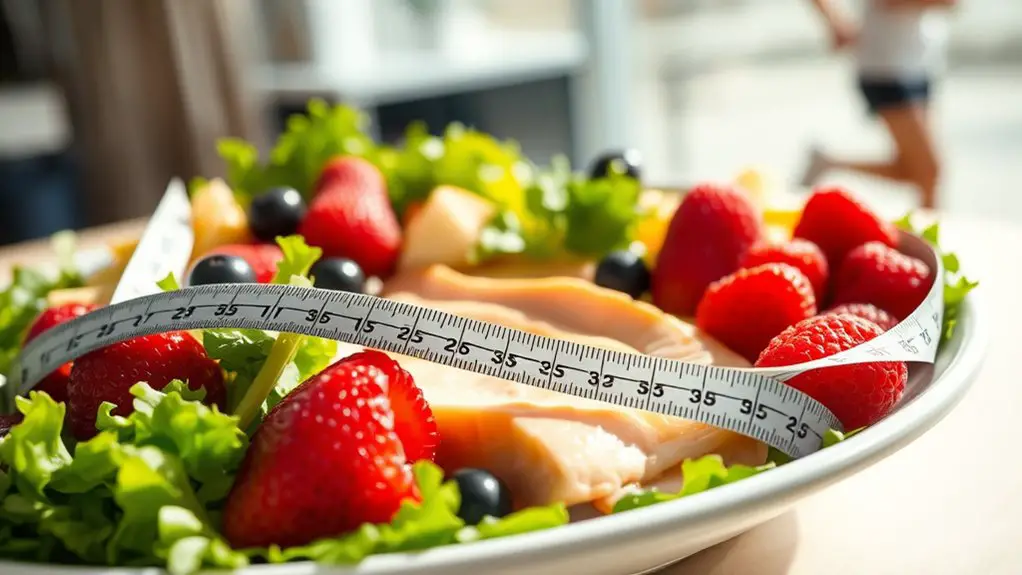The Truth About Spot Reduction and Fat Loss

Spot reduction is a myth; you can’t lose fat in just one area of your body. Fat loss happens throughout your entire body and requires a combination of diet, exercise, and lifestyle changes. Engaging in cardio and strength training effectively supports overall fat loss. Remember, it’s essential to adopt a holistic approach for the best results. If you’re keen to learn more about how to optimize your fat loss journey, there’s much more to explore.
Understanding Fat Loss: The Science Behind It

When you think about fat loss, it’s important to understand the science behind it, as this knowledge can empower you to make informed decisions about your health. Your body’s metabolism plays a key role in how efficiently you burn calories. Several metabolism factors, like age, genetics, and muscle mass, can influence your fat loss journey. The more muscle you have, the higher your resting metabolic rate, meaning you burn more calories even at rest.
Hormonal influences also greatly impact fat loss. Hormones like insulin, cortisol, and leptin regulate appetite and fat storage. For instance, high insulin levels can lead to increased fat storage, while balanced hormones promote fat loss. Understanding these elements can help you tailor your approach to fat loss, ensuring it aligns with your unique body chemistry. By focusing on these scientific principles, you can create a sustainable and effective fat loss strategy that works for you.
The Myth of Spot Reduction: Why It Doesn’t Work
Although many people wish they could target fat loss in specific areas, the reality is that spot reduction is a myth. Research shows that when you lose fat, your body draws from fat stores throughout, not just from the area you’re exercising. For instance, doing countless crunches won’t exclusively burn belly fat; it might even leave you feeling frustrated.
Instead, focus on a thorough approach that combines regular exercise and overall calorie deficit. Engaging in a mix of cardio and strength training can help you achieve balanced fat loss. Remember, you can’t choose where your body loses fat, but you can control your overall fitness journey. Incorporating exercises like skipping rope can enhance your cardio workouts and contribute to overall weight loss.
Stay motivated by setting realistic goals and tracking your progress. Embrace the idea that true fat loss comes from a comprehensive lifestyle change rather than trying to spot reduce. Your body will thank you for it in the long run!
The Role of Diet in Overall Fat Loss

While exercising is essential for fat loss, diet plays an equally important role in achieving your goals. To maximize your efforts, focus on these key aspects of nutrition:
- Caloric Deficit: To lose fat, you need to consume fewer calories than you burn. This deficit encourages your body to use stored fat for energy.
- Nutrient Timing: When you eat can be just as vital as what you eat. Consuming balanced meals around your workouts can enhance performance and recovery.
- Whole Foods: Prioritize whole, nutrient-dense foods over processed options. These foods provide essential vitamins and minerals that support your metabolism and overall health.
Effective Exercise Strategies for Fat Loss
To achieve effective fat loss, incorporating the right exercise strategies is vital, as they can greatly enhance your results. High intensity interval training (HIIT) is one of the most efficient methods to torch calories and boost your metabolism. By alternating short bursts of intense activity with periods of rest, you can maximize fat loss in a shorter amount of time.
In addition to HIIT, strength training techniques are important for building muscle, which in turn increases your resting metabolic rate. By incorporating compound movements like squats and deadlifts, you’ll engage multiple muscle groups, promoting overall fat loss. Adding activities like jump rope workouts can further enhance your cardiovascular fitness and calorie burn.
Aim for a balanced routine that combines both HIIT and strength training for best results. Consistency is key, so find activities you enjoy to stay motivated. Remember, every workout you complete brings you one step closer to your goals. Start implementing these strategies today, and watch your progress unfold!
Setting Realistic Goals for Your Fat Loss Journey

Setting realistic goals for your fat loss journey is essential, as it can greatly influence your motivation and overall success. By focusing on achievable targets, you’ll make significant progress without feeling overwhelmed. Here are three key aspects of effective goal setting:
- Specificity: Define clear, specific goals—like losing 1-2 pounds per week.
- Measurable Milestones: Break your journey into smaller, measurable goals, such as weekly workout sessions or daily water intake.
- Flexibility: Be open to adjusting your goals based on progress and lifestyle changes.
Frequently Asked Questions
Can Genetics Affect Where I Lose Fat First?
Yes, genetics can definitely affect where you lose fat first. Your body’s fat distribution is largely influenced by your genetic makeup, which determines how and where you store fat. Some people may notice weight loss in their face or abdomen first, while others might lose it in their thighs or hips. Understanding this can help you set realistic goals and stay motivated on your fitness journey, knowing that your body has its own unique pattern.
How Long Does It Take to See Fat Loss Results?
When it comes to your fat loss timeline, most people start seeing visible results within 4 to 8 weeks, depending on factors like diet, exercise, and individual metabolism. Staying consistent with your routine is key—embracing healthy eating habits and regular workouts will help you achieve your goals. Remember, everyone’s journey is unique, so focus on progress rather than perfection. Celebrate small victories along the way; they’ll motivate you to keep pushing forward.
Is There a Best Time to Exercise for Fat Loss?
Studies show that people who work out in the morning tend to be more consistent, with a 30% higher likelihood of sticking to their routine. While morning workouts can boost metabolism and energy levels throughout the day, evening sessions may be ideal for strength training, as your body’s temperature is higher and muscles are more flexible. Ultimately, the best time to exercise for fat loss is when you’re most likely to stick with it.
Do Supplements Help With Fat Loss or Spot Reduction?
Supplements can play a role in fat loss, but they’re not magic solutions. Natural supplements might aid in fat burning when combined with regular exercise and dietary changes. They can boost energy levels or support metabolism, making your workouts more effective. However, you shouldn’t rely solely on them; focus on a balanced diet and consistent exercise. When you combine these elements, you’ll see better results and feel more motivated on your journey.
Can Stress Impact My Fat Loss Journey?
You might not realize it, but stress could be sabotaging your fat loss journey. When you’re stressed, your cortisol levels rise, which can lead to weight gain, especially around your midsection. It’s essential to adopt stress management techniques like mindfulness, exercise, or deep breathing. By addressing stress, you’ll not only feel better mentally but also support your body’s ability to shed those extra pounds. Remember, a calm mind fosters a healthier body.





